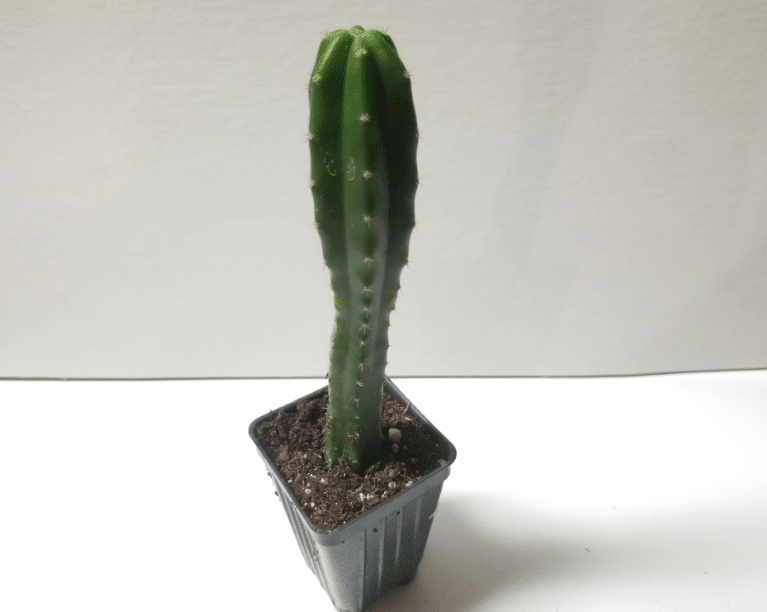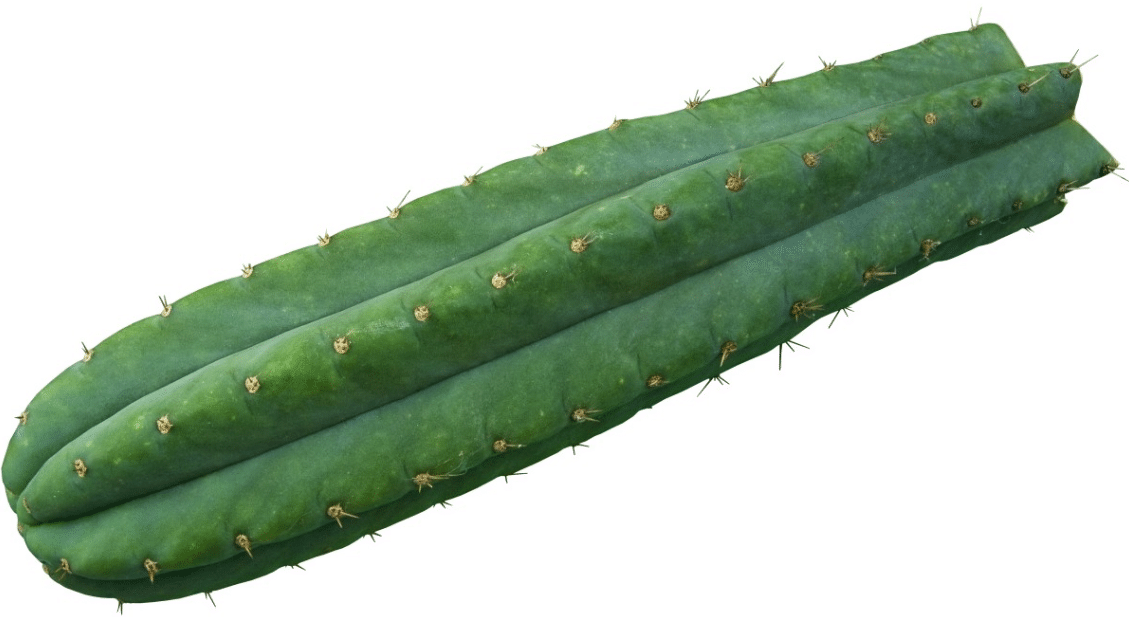San Pedro Cactus: Echinopsis pachanoi (Known as San Pedro cactus — is a fast-growing columnar cactus native to the Andes Mountains at 2,000–3,000 m (6,600–9,800 ft) in altitude. It is found in Argentina, Bolivia, Chile, Ecuador, and Peru, and it is cultivated in other parts of the world. Uses for it include traditional medicine and traditional veterinary medicine, and it is widely grown as an ornamental cactus. It has been used for healing and religious divination in the Andes Mountains region for over 3,000 years. It is sometimes confused with its close relative Echinopsis peruviana (Peruvian torch cactus).
Its magico-religious and medicinal use was suppressed by the Catholic conquistadors,[4][6][11] but not nearly as much as peyote’s. Its early association with Christian symbols and holidays appears to have helped; in fact, it may have been strategic. San Pedro curanderismo (folk healing) ceremonies were held on June 24th, the Nativity of Saint John the Baptist,[10] for example, while the name of the plant itself, San Pedro, Spanish for Saint Peter, is thought to imply that, like the Christian saint, the cactus “holds the keys to heaven.

Caring for an san pedro cactus
San Pedro cactus is resilient, requiring bright light and infrequent watering. Caring for this cactus means allowing the soil to completely dry out between waterings to prevent root rot.
In addition to its primary care, the San Pedro cactus benefits from a well-draining cactus mix to facilitate proper water management. Fertilize sparingly; a balanced, slow-release fertilizer applied once during the spring supports its growth phase. As a columnar cactus, it can grow quite tall, so ensure it has ample vertical space. While it can withstand drought, it’s less tolerant of cold temperatures. During winter, decrease watering substantially and protect it from frost. Repotting should be done every other year to refresh the soil, but be gentle with the roots to avoid stress. Remember, patience is key while it grows faster than many cacti, it still takes time to reach its full majestic height.
San Pedro Cactus Growth
The San Pedro cactus is known for its rapid vertical growth, potentially reaching 10-20 feet in height. It can expand about 5-6 feet in width, providing a robust presence in a garden. With optimal care, including ample sunlight and a temperate climate, it can grow approximately 12 inches annually.
When cultivating a San Pedro cactus, it’s crucial to provide a stable environment that supports its rapid growth. This cactus prefers a mix of full sun and partial shade, especially in hotter climates, to avoid sunburn. It’s adaptable to various soil types, provided they are well-draining. Regular watering during the growing season aids its speedy development, but always ensure the soil is dry before the next watering. In colder months, reduce watering significantly. Pruning isn’t typically necessary, but if you choose to prune for shape or propagation, do so carefully to maintain the plant’s health. San Pedro’s are resilient and can handle occasional neglect, making them suitable for gardeners of all levels. They are also known for their beautiful white, fragrant flowers that bloom at night, adding a unique charm to their fast-growing stature.

Propagating San Pedro Cactus
Propagating San Pedro cactus is achievable through cuttings, seeds, or grafting. Cut a healthy stem and allow it to dry before planting in well-draining soil. For seed propagation, prepare the soil and plant the seeds, maintaining the right moisture and sunlight levels. Grafting involves attaching a San Pedro cutting to a different cactus species’ rootstock. Regardless of the method, provide sufficient light and consistent temperature to encourage rooting and growth.
San Pedro Cactus For Sale
If you are looking for healthy, rooted San Pedro specimens, many of which are blooming, look no further. If you haven’t seen a San Pedro cactus bloom, you haven’t seen flowers! Their flowers are giant, 8, 10, 12 plus inches in length, white, fragrant, and bees and other flying insects love rolling around in them! Tortoises love to eat them as well! My dad cuts their flowers each morning and lays them out along with cut nopales cactus for their 8 tortoises to feast on during the summer.
Read Also: thread beast baller package
Checkout store www.thesucculentsource.com for our Trichosurus that we sell, or contact us directly via email We have a licensed CA Nursery and have lots of other flower blooming and decorative cactus and succulents available.
San Pedro Cactus Trip
However, of course, you would like to know by now what this heavenly plant can do for you. Like peyote, the most important active ingredient in the San Pedro is mescaline, a psychoactive alkaloid. Many cosmonauts actually prefer the San Pedro over the peyote, because San Pedro is somewhat milder for you in several ways. First, the taste – although still bitter – is less pronounced than that of peyote. Also, the chance of nausea is slightly less. The trip itself is also a bit more gradual and is generally less intense and overwhelming than when using peyote. Yet San Pedro is certainly not a dull drug: prepare yourself for a strong, dreamy, visual trip.
The trip starts after about one to two hours, and in addition to the fairytale feeling, it entails an increased perception of details and light. A spiritual or loving feeling for people and the world around you takes hold of many cactus eaters. This imaginative journey can take about 8 to 15 hours.
San Pedro Cactus Powder
Organic San Pedro Cactus (Trichocereus Pachanoi) This is top quality powder brought to you fresh from Peru. The San Pedro Cactus powder is 100% flesh, no core , no spines. Huachuma (San Pedro cactus) has a long history of shamanic use, specifically by the shamans in the Andes Mountains of Peru and Bolivia. Andean tribes have used San Pedro cactus incense for decision making, healing, spiritual guidance.
Read Also: Roberta Roller Rabbit Bedding And Pajamas
San Pedro Cactus is considered the greatest of all the plant teachers on the South American continent. South American shamans use this plant as medicine. San Pedro cactus has been used to treat a broad range of physical, mental and emotional disorders, as well as people with addictions such as alcoholism. It has been used quite regularly throughout South America for a long time to enhance life and connect the people to “Pachamama” (Latin term for Mother Earth).
San Pedro Cactus Preparation
If you wish to find San Pedro growing in the wild in Ecuador and Peru, there are plenty of places to do it, but it does take some searching. Your best bet is the eastern slope of the Andes, within the elevational range of 1,800 to 2,800 meters above sea level. In addition to San Pedro (Echinopsis pachanoi), there are a few other mescaline-containing species of cacti in the Echinopsis (syn Trichocereus) genus, most notably Peruvian Torch (Echinopsis peruviana).

- Carefully remove the spines and shave the outside of the cacti to remove the small hairs. Take care not to remove too much of the skin as you don’t want to waste any of the precious pulp beneath
- Adding water to the plant matter, allow it to simmer in a pan for 1-2 hours over moderate heat. The water will need to fill half the pan and can be topped up throughout the simmering process to avoid burning the cacti.
- This can be done by scraping the now softened flesh with a knife. Place the cacti with the skin against the worktop and using the knife, scrape away from you. The subsequent pulp can be collected.
- According to the Erowid Essential Psychedelic Guide, you have to boil it for several hours. We usually do 2-3 hours. Some people state that boiling it longer makes it more drinkable as the snot-like emulsion breaks down and might reduce nausea.
- This step can be performed in a number of ways, but the ultimate goal is to ensure the paste that you are left with is as dry as possible. You could leave it out to dry naturally, but this will likely take a few days.
San Pedro Cactus Seeds
San Pedro cacti bloom in midsummer, but their fruit doesn’t fully ripen until early autumn. The seeds should be gathered once the fruit ripens to a pinkish color and produces an abundance of brownish, hairlike structures on the outside. Remove the spongy matter from inside the fruit, then pick out the tiny black seeds. The seeds germinate best when fresh, so sow them in autumn immediately after gathering them.
Is The San Pedro Cactus Hallucinogenic?
The San Pedro cactus is the name given to psychoactive species of the genus Trichocereus (T. pachanoi, T. peruvianus) which comprises about thirty species, mainly found in the Andes. It is a large columnar cactus that grows up to heights of twenty feet and it contains mescaline, as does the well-known peyote cactus.
Is It Legal To Buy San Pedro Cactus?
Today San Pedro is officially recognized by the Native American Church as an alternative to peyote. Early on the nearly spineless E. pachanoi was introduced into the U.S. as a rootstock for grafted cactus. While it is legal to grow San Pedro cactus as an ornamental plant, extracting its mescaline is illegal.
How Long Does A San Pedro Trip Last?
Approximately 1-2 hours after consumption the San Pedro will reveal itself to the user; effects can last 8-15 hours.
Is San Pedro Cactus Dangerous?
With a sample group of about 30 000 mescaline users, one of every 70 000 ingestion was categorized as a “bad trip”. Mescaline also causes no physical addiction. There have been no reports of overdose effects or lethal consequences of mescaline use.



